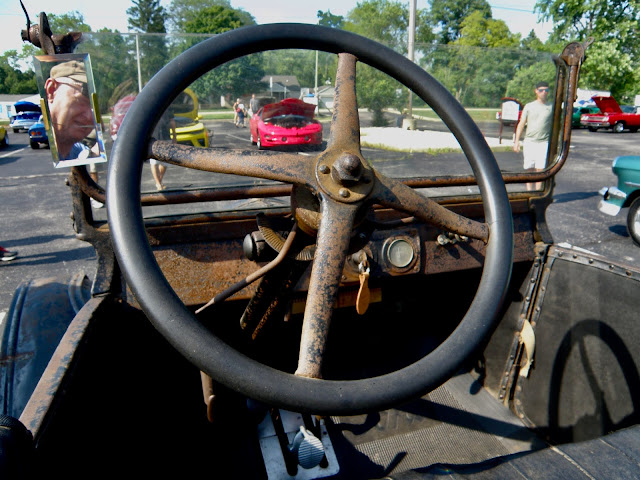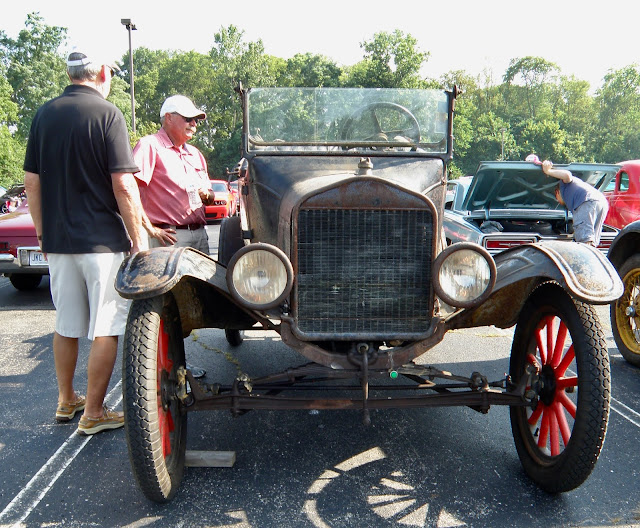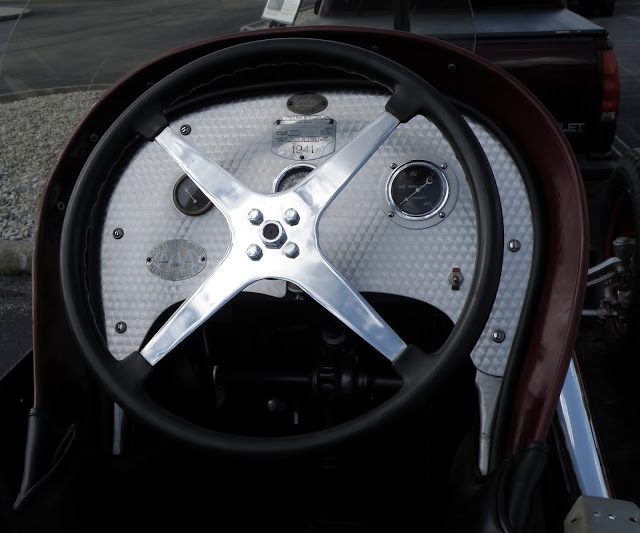Well, I decided to photograph my own car tonight, a Volvo Wagon that I have never taken to a car event. This is undoubtedly the best car we have over owned. It looks great, everything works, is fast and safe. When I had 4 cars -- before I sold the 1971 Porsche 911T targa -- this car was rarely used, with the exception of taking yard waste to the dump. But it now has new life, and I have discovered just what a joy it is to drive! Car folks at these cruise-ins want to see hot rods, Detroit muscle, some unusual foreign cars perhaps, but not a Volvo unless it is a P1800. This car is faster than most, and can stop as well.
This blog will expand on themes and topics first mentioned in my book, "The Automobile and American Life." I hope to comment on recent developments in the automobile industry, reviews of my readings on the history of the automobile, drafts of my new work, contributions from friends, descriptions of the museums and car shows I attend and anything else relevant. Copyright 2009-2020, by the author.
Saturday, July 31, 2021
An Unmolested Ford Model T at the Vineyard Cruise-In, July 30, 2021
Since I have been so focused on Walter Wanderwell, And after 1921 Walter used Ford Model Ts on his expeditions, I found it interesting to see this wonderful original Model T at the Greene County cruise-in last night. It was such a simple and rugged car, and this one took me back to the early 1920s. Although I could not drive it, as I am unfamiliar with the pedal arrangement and transmission!
Friday, July 30, 2021
Complicity in the Murder of Walter Wanderwell
I am breaking in my post chronology because of this photo that turned up today while grazing newspapers.I don't have the source but will find it next time I sit down and work on this topic.
The other day I read a blog post that had a reply stating that there was no question that Aloha, her 2nd husband and William Guy conspired to kill Walter Wanderwell. I replied to that statement by asking for evidence. Then I saw this photo today.
Certainly there has to be much more before this unsolved murder can be solved.And most likely it will never be solved.
But the photo is suggestive. And even more important, Aloha appears to be far more than the innocent young lady portrayed in the massive public relations campaign to promote her as "the first woman to drive around the world" and other material of similar ilk. Cigarette in her mouth and with a dusky look, Aloha's image here suggests the possibility that she could well have been a part of Walter Wanderwell murder story!
Monday, July 26, 2021
The Race That Put AMG on the Map: The 1971 24 Hours of Spa Francorchamps
AMG 300 SEL 6.8 racing touring car based on the Mercedes-Benz 300 SEL 6.3 (W 109) luxury saloon. At the 24-hour race in Spa-Francorchamps in 1971, Hans Heyer and Clemens Schickentanz attained second place overall, causing a sensation.
This race put AMG on the motorsport map overnight: at 3 p.m. on 24 July 1971 almost 80 racing touring cars started the 24 Hours of Spa-Francorchamps. Right in the middle of the field there was a mighty Mercedes-Benz luxury saloon of the W 109 model series driving the course in the Ardennes. It was not a works racing car, but a vehicle used by the engineering firm founded by Hans Werner Aufrecht and Erhard Melcher in 1967.
AMG comprehensively prepared this predecessor of the Mercedes-Benz S-Class for the long-distance race; the emphasis was on the engine and chassis. The technical data were tremendous for racing touring cars of the time: 315 kW (428 hp) from 6,835 cubic centimetres of displacement, up to 620 newton metres of torque, a top speed of more than 265 km/h and an acceleration capacity from 0 to 100 km/h in 6.1 seconds. AMG 300 SEL 6.8 was the name of the red racing car – even if the star on the cooler clearly indicated the brand from Stuttgart.
Fascinating start-up
The company name AMG was not yet widely known in 1971, familiar primarily to lovers of performance-enhanced Mercedes-Benz cars with sporting ambitions. The first letters of the surnames Aufrecht and Melcher and the town Großaspach (where the two founders worked on racing engines together for the first time in the 1960s) provide the acronym. The headquarters were a former mill in the neighbouring town of Burgstall.
By the end of the 1971 24 Hours of Spa-Francorchamps, the AMG brand had gained a reputation in the world of racing overnight. For Hans Heyer and Clemens Schickentanz took the 300 SEL 6.8 to sensational second place finish overall and secured victory in their class. Even the renowned ARD news programme “Tagesschau” reported on the racing coup in Belgium. The magazine “auto motor und sport” celebrated it as a “stroke of Swabian genius”.
The “incredible second place”
However, this race success 50 years ago was by no means a given. After all, this big saloon weighing 1,635 kilograms (still 195 kilograms lighter than the series version) had to assert itself in a field of nimble racing touring cars in this Belgian marathon race. Luckily the vehicle suited the old course of Spa-Francorchamps – 14.863 kilometres long and with many straights that could be driven at full throttle. The 300 SEL 6.8 held its own and sped dependably through the night as more and more vehicles dropped out of the race: at daybreak 23 cars were still going; entire factory teams had withdrawn. The outsider from Affalterbach kept right on track and was ultimately the second vehicle of the 18 remaining racing touring cars to cross the finish line.
The magazine “Road & Track” reviewed the successful balancing act between power and weight: “During the race, the big V8 had an insatiable thirst for fuel, and its weight meant that it quickly wrecked its tires. However, the straight-line speed of the Red Pig more than made up for its inefficiencies on the long straights of Spa-Francorchamps, and after 24 hours, it ended up storming its way to an incredible second place behind a Ford Capri.” The drivers of the Ford were the former Mercedes-Benz racing driver and current Mercedes-Benz Brand Ambassador Dieter Glemser along with the Spanish racing driver Alejandro “Àlex” Soler-Roig.
Reminder of the historic victory at the 2021 24 Hours of Spa-Francorchamps
For the performance and sports car brand Mercedes-AMG and for Mercedes-AMG Motorsport, the success at the 24 Hours of Spa-Francorchamps 50 years ago was a milestone in their brand history. This year, a total of 13 customer team Mercedes-AMG GT3s are taking part in the 24 Hours of Spa-Francorchamps (31 July to 1 August 2021). One of the GT3s is doubly reminiscent of the anniversary: its design is based on the racing touring car of 1971 and it also has the starting number 50.
Saturday, July 24, 2021
Kettering Towne Center Cruise-In, July 24, 2021
The first two photos are of Julie's 1959 Thunderbird. I love the color of this car. It appears to be a true survivor, with original paint and interior.
About ten people were on the curb to Dorothy Lane with American and "Don't Tread on Me" flags. Talked to a man with the microphone, the "Team Leader." His organization is the Ohio Patriots Alliance, Dayton Chapter. He is from Beavercreek. They are "Standing up for America." On the back of his card is "Absolute Proof." And a U.S. map with several states in blue --GA, PA WI, MI, NV, AZ.
They are there to rally around the flag as patriots, and to celebrate American freedoms, including the right not to wear a mask.
Not what I expected to see at a car show.
Friday, July 23, 2021
1971 International Harvester "Johnnie Reb" Edition Pick-Up Truck
Wednesday, July 21, 2021
James Garner and "Grand Prix," 1966 -- Technical Innovations Developed During the Filming
John Frankenheimer’s Grand Prix (1966) was a European racing spectacular of this period, but was far more slow-moving than Le Mans. What Frankenheimer contributed to the genre, however, was technical; his use of NASA-developed cameras and microwave systems, monster camera cars that were capable of 150 mph, and helicopters, were imitated in other films, and set a benchmark in terms of realism.
In the 2011 autobiography The Garner Files: A Memoir (New York: Simon & Schuster, 2011), Garner had this to say about the making of the film: (p. 106-7)
Frankenheimer wanted to put viewers in the car and give them the sensation of speed. But he didn't cheat anything: no rear projection, no process shots, no speeded up footage. The technology he needed to get the realism had to be invented. Special effects man Milt Rice rigged a motorized, swiveling cockpit for closeups of spinouts, and devised a tubular catapult charged with compressed nitrogen that was in effect a cannon for Formula One cars. In a split second, it could launch a mock-up car -- with or without a dummy in it - from a standstill to 120 mph.
Because Freankenheimer was obsessed with details, the movie is almost a documentary in terms of racing. Someone called it a "porno film for gear heads," with tight close-ups of instri=ument needles, spinning wheels, drive shafts, suspensions, gear changes, heal-toe pedal work. the sound is deafening, with the thundering roar of engines and cars surging off the line. Sound effects editor Gordon Daniel prerecorded a whole library of motor sounds with Phil Hill driving on a straightaway in California. Phil simulated hundreds of gear changes specific to the corners on all the circuits. Gordon then matched them in postproduction to what the drivers were doing on htescreen, so aficionados heard the exact sounds they expected at every corner of every track.
Former World Champion Phil Hill drove the camera car, a Ford GT-40, a Lemans-type racer capable of hitting 200 mph. Some fo the camerawomen techniques invented for Grand Prix are still in use today [2011], including helicopter shots, some of which were taken from only ten feet above the action. There were complaints about it flying too low, so they backed off for a while...then went back to flying low again. How low? The cameraman, John Stephens, would hang out of that chapter with his feet dangling, and at the end of the day, his pant legs would be green from brushing the trees.
Lionel Lindon was the cinematographer, but Saul Bass directed the second unit and designed the multiscreen montages. the technique first appeared in the 1960s and soon became a cliche, but at the time uit was revolutionary, and all the more striking in Cinema, a process that doubled or tripled the size of the screen and curved it around the audience. With a high-quality sound system and advanced cinematography, some viewers actually got motion sickness.
NASA developed special microwave cameras to be mounted on the cars. Johnny Stephens put cameras over the wheels, on hoods, in drivers' laps. Those big, heavy, 70mm cameras -- housed in special plastic shields to protect lenses from picked up pebbles and rain- were difficult to work with. Mounted on the chassis, they upset theaerodynamds so much that the cars had to be counterweighted. Sevens rigged special remote controls for them and experimented with anti vibration mounts. He finally decided to let the camera shake because it looked sexier. Today's cameras are so tiny they can fit several in the cockpit without bothering the driver, and television viewers are used to seeing the driver form the cockpit. But in those days, Frandkenheimer struggled for months trying to shoot from the driver's point of view until Bell ball created a camera that could be strapped to the driver's helmet.
Tuesday, July 20, 2021
A Brief Review of Henry Dominguez, "The Cellini of Chrome: The Story of George W. Walker/ Ford Motor Company's First Vice President of Design"
The Cellini of Chrome: The Story of George W. Walker/ Ford Motor Company's First Vice President of Design (Boston: Racemaker Press, 2020) was an absolute pleasure to read. The illustrations, photographic images, and accompanying captions comprise a thoughtful story unto itself. Family photographs, in addition to material from brochures, and public relations materials result in a rich visual experience.
This book tells several stories starting with the life, career, personality, and eccentricities of one of the most important automotive (and other durable product ) designers of the 20th century. During the Golden Age of the automobile in America we normally first think of Harley Earl (1893 - 1969) as the person who transformed automobiles to be longer, lower and wider -- until we get to the late 1950s when the "dinosaur in the driveway" became commonplace in suburban driveways.
But there were many other designers who played a role in this aesthetic transformation of trasnportation. Raymond Loewy (1893-1986), for example, with his 1947 and 1953 Studebakers; Virgil Exner (1909-1973) and his "Forward Look" Chrysler Corporation Models; and George W. Walker (1896-1993) at Ford, with his 1949 and 1957 Fords. Walker was a designer and illustrator, but in the case of automotive design he was more of a manager and salesman, first working as a consultant and then as the first Vice President of design at Ford. He may not have worked closely on the models, but the cars were his.
Dominguez's book is a biography of Walker but much more. It covers an important history of one aspect of automotive design and an insider's tale of working at Ford. Virtually every important model of Ford, Mercury, Lincoln and pick up trucks are examined with a careful eye to detail. I found myself learning so much about aspects of design as I turned the pages.
The man Walker was always tanned and looked like a designer. He had a great smile and a way with the ladies, so much o that he was described as a "cocksman" who -- it was claimed -- had sex with his secretary in his office on every birthday. Yet. it was also claimed that he was a family man who placed his wife Freda first. He was a complex individual working in a complex business setting. Walker trusted his lieutenants and rewarded those who worked for him who were successful. But he could be harsh, petty, and vengeful as well.
While this book gets a bit laborious in details at times - The transcript to Walker's episode on the TV show "To Tell the Truth" could have been omitted -- the details can also bring out a human side that is rarely found in any book in automotive history. For example, the last months and days of Walker's life are quite touching, and bring out the best of Dominguez as an author.
I have two issues that need to be addressed, however, because I read this book. First, there are no references or tags that can help us reconstruct what the author was saying in his writing. What were his sources? How did he put this story together? There are many, many quotes of various designers and others, but how can we get a sense of how authoritative they are? Yes, this is a "coffee table" book, and not a work oof academic scholarship. But it will also be a starting point for future scholars, and it is a history that should be respected as such. Secondly, the cost of this book and its target consumer market will probably result in this book not making it to online few at best university or public libraries. That is a shame, because this knowledge is very important, and interested readers need to take the content of this work in.
If you are lucky enough to get this book, you most likely will heartily enjoy it. It is a must read for those interested in the American automobile industry during the 1950s and early 1960s.
Sunday, July 11, 2021
A Remarkably Beautiful Crystal Hood Ornament
I took this photo on the fly at the Concours in South Bend, Indiana, yesterday. As I remember it was on a 1930s Cadillac, but can say little else. What is more to say about this most beautiful and valuable accessory?
Saturday, July 10, 2021
Tailfins at the Concours D'Elegance at Copshaholm, South Bend, IN, July 10, 2021
Here are a few of the tailwind that were at the Concours today. Weather held out, and crowd was treated to a number of very special cars. My neighbor Bob Werner brought his 1957 Cadillac Eldorado Brougham, a stunning red car that reflected the 20th century American automotive industry at its very best. Perhaps this model was the best production car ever made!
Saturday, July 3, 2021
Friday Night Cruise-In: 1938 Pop Dreyer Sprint Car
Raced between 1938 and 1956, with a long list of prominent drivers. Seen at the Greene County Cruise-In at The Vineyard, July 2, 2021. It featured a twin camshaft head over a Ford block made by Pop Dreyer and dual downdraft Winfield carbs.


























